
|
![]()
Greatest Films of the 1930s
1930 | 1931 | 1932 | 1933 | 1934 | 1935 | 1936 | 1937 | 1938 | 1939
Title Screen Film Genre(s), Title, Year, (Country), Length, Director, Description 



Alice Adams (1935), 99 minutes, D: George Stevens
An RKO social drama adapted from Booth Tarkington's 1921 novel. A silent version was released in 1923. A likeable, small-town teenager Alice Adams (Katharine Hepburn) was from a middle-class background in a midwestern town, but frustrated because she desperately wished to be accepted by her upper-class peers. She was embarrassed by her family's social status and her father's lack of ambition, so she convinced her friends that she was from a wealthy family. At a high-society party, she met a wealthy, handsome young man Arthur Russell (Fred MacMurray) and told him fanciful tales of her family's fortunes. She invited him into her home and in the memorable scene at the disastrous dinner table, everything went wrong as it was painfully obvious what her social circumstances really were.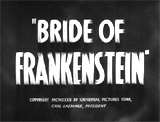


Bride of Frankenstein (1935), 73/90 minutes, D: James Whale
A frightening, but campy, classic horror film, a sequel that bettered the original, and preceded the next film with an all-star horror cast, The House of Frankenstein (1944). A masterpiece from Universal horror director James Whale. Remade as The Bride (1985), starring Sting and Jennifer Beals. The delightfully evil but weird scientist Dr. Septimus Pretorius (Ernest Thesiger) compelled and convinced Dr. Henry Frankenstein (Colin Clive) to artificially make a female companion/mate (Elsa Lanchester) to placate the lonely Monster (Boris Karloff), who had been terrorizing the countryside. In this version, the monster was more human-like, and could even speak a few words. (The monster had escaped death from the fiery castle at the end of Frankenstein (1931), the previous film). The humorous creation/"birth" scene of the Bride was an unforgettable classic.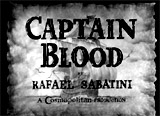


Captain Blood (1935), 119 minutes, D: Michael Curtiz
A classic adventure film swashbuckler, Errol Flynn's first starring role, and the first of eight romantic pairings with co-star de Havilland. A young 17th century Irish physician/surgeon Dr. Peter Blood (Errol Flynn) was wrongly condemned by a judge for participating in the Monmouth uprising and aiding the rebels by treating their wounds. He was sold into plantation slavery in the Caribbean (Jamaica). He was purchased by the beautiful niece Arabella Bishop (Olivia de Havilland) of a brutal plantation owner, but escaped his unfair sentence and became a leader of a band of fearsome Caribbean pirates. He launched his own battle against Col. Bishop, the colonial governor of Jamaica (Lionel Atwill) in a number of stirring action sequences including sea battles and bombardments and a fencing duel with rival villainous pirate Capt. Levasseur (Basil Rathbone). He also charmingly romanced Arabella.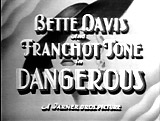


Dangerous (1935), 78 minutes, D: Alfred E. Green
Considered the ultimate soap-opera. An idealistic, aspiring, handsome architect Don Bellows (Franchot Tone) attempted to rehabilitate and save an alcoholic former great Broadway star Joyce Heath (Bette Davis) from despair. He sponsored the tempestuous star's comeback in a stage play by bankrolling her efforts. In the process, he lost his heart to her romantically (while breaking off his engagement to his adoring wealthy socialite Gail Armitage (Margaret Lindsay), despite the presence of Joyce's husband Gordon Heath (John Eldredge). When Gordon refused to give his wife Joyce a divorce, she intentionally ran the car into a tree and paralyzed him for life. Joyce was guilt-ridden after the deliberate accident, vowed to take care of Gordon, and sent Don back to Gail. Notable for Bette Davis winning her first Best Actress Academy Award, possibly as a consolation prize because she didn't win for Of Human Bondage (1934) a year earlier.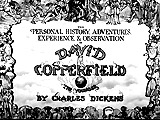



David Copperfield (1935, UK), 133 minutes, D: George Cukor
The definitive Hollywood/UK film adaptation of the 1850 Charles Dickens novel, the first and possibly the best of all film versions of Dickens' works. It was the story of young David Copperfield's (Freddie Bartholomew/Frank Lawton) growth to manhood in 19th century England. He lived an idyllic life at first with his recently widowed mother (Elizabeth Allan) and his nurse until his mother married the despicable and mean Mr. Murdstone (Basil Rathbone). When she died while he was away at boarding school, the orphaned David was forced to return home and go to work in his stepfather's sweat-shop warehouse under grim child labor conditions. He ran away to Dover to his eccentric Aunt Betsey (Edna May Oliver) and eventually survived all his trials to become an author, who eventually married his childhood sweetheart Agnes (Madge Evans). With unforgettably colorful secondary characterizations, especially the impoverished but philosophical Micawber (W. C. Fields) and villainous Uriah Heep (Roland Young).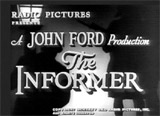

The Informer (1935), 91 minutes, D: John Ford
One of John Ford's greatest films, an Academy-Award winner based on the novel by Liam O'Flaherty. This profound expressionistic study of life in 1922 Dublin, Ireland was during the time of the violent Irish Sinn Fein civil rebellion. Gypo Nolan (Best Actor-winning Victor McLaglen), a big, slow-minded, hard-drinking Irish Dubliner, had been ejected from the IRA for refusing to shoot a deserter. Unemployed, he committed the ultimate traitorous act by revealing the identity and betraying his IRA leader and friend Frankie McPhillip (Wallace Ford) in order to collect a twenty pound reward from the hated British Black and Tans - money he hoped would pay for passage to America. Thereby, he began a downward spiral, especially after his friend died in custody. He was regretful, devastated and tormented by his decision and his conscience, drank away his reward money, and was put on trial (where he falsely accused Peter Mulligan (Donald Meek)) and became the object of revenge by the IRA.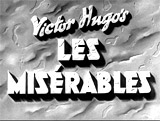

Les Misérables (1935), 108 minutes, D: Richard Boleslawski
The first (and some consider the best) of the many film adaptations of Victor Hugo's novel of 19th century France, with beautiful cinematography by Gregg Toland. This is the classic story of good and evil in an unforgiving and unrelenting legal system. Jean Valjean (Fredric March), who had stolen a loaf of bread to survive, was captured and given 10 years of hard labor. He escaped prison and rebuilt his life, becoming a respectable mayor of the town where a truly frightening and vengeful Javert (Charles Laughton) was chief of police. Valjean was identified as a wanted criminal, and then tormented by the unimpassioned, obsessed, and single-minded Javert, who would not let the past be forgotten. Not to be confused with the French 1934 version.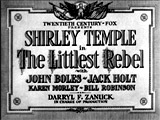


The Littlest Rebel (1935), 70 minutes, D: David Butler
One of famous child star Shirley Temple's most well-known 20th Century Fox pictures, although some criticized the film's sequence in which Shirley masqueraded in black face disguise as a "pickinniny," and the film's over-idealized view of slavery. Set in the South during the Civil War, young Virginia "Virgie" Houston Cary (Shirley Temple) was the six-year-old daughter of Confederate rebel officer Capt. Herbert Cary (John Boles), who was jailed trying to sneak back through Union lines with her after visiting his sick wife Helen (Karen Morley) in a rundown slave cabin. She saved her father from being executed as a Confederate spy by charming President Abe Lincoln (Frank McGlynn Sr.), sharing an apple with him. Notable for its tap-dancing duet highlight "Polly Wolly Doodle" by Shirley Temple and Uncle Billy (Bill "Bojangles" Robinson).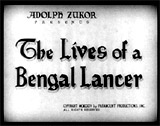


The Lives of a Bengal Lancer (1935), 109 minutes, D: Henry Hathaway
An escapist, rousing classic adventure film. A tale of the British Empire at the time of its vast colonial holdings, and about three British soldiers serving in the 41st regiment in an exotic land. Set on India's remote rugged Northwest frontier were three British Bengal Lancers: the seasoned and fearless Scottish-Canadian Lt. Alan McGregor (Gary Cooper), gung-ho Lt. John Forsythe (Franchot Tone), and the naive, raw, untested recruit Lt. Donald Stone (Richard Cromwell) - the bitter son of a stern, high-ranking commanding official Col. Tom Stone (Guy Standing). The two soldiers attempted to rescue Stone after he was captured by warring chieftain Mohammed Khan (Douglas Dumbrille), and were captured and tortured themselves. With an exciting conclusion and battle - in which the trio of British soldiers found themselves fighting from inside the enemy's mountain fortress, as the Lancers attacked and laid siege. In the end, Lt. Stone redeemed himself by killing Khan, although McGregor died during the fierce assault.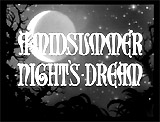


A Midsummer Night's Dream (1935), 132 minutes, D: Max Reinhardt, William Dieterle
A fanciful film version of William Shakespeare's play, with lavish sets, costumes, choreography, and a tremendous all-star cast. It was the first major Hollywood attempt at a Shakespearean play, and won two Oscars - Film Editing and Best Cinematography by replacement film-maker Hal Mohr (a write-in nominee/candidate). It was also the sole sound feature film of German experimental theater director Max Reinhardt. Classical composer Mendelssohn's music was adapted by Erich Wolfgang Korngold. It told the story of mythical and mischievous forest creatures (fairies and artisans) who planned to put on a play for the amusement of the royal court at a royal wedding. Instead, the tale became one of a battle between the King Oberon (Victor Jory) and Queen Titania (Anita Louise) of the fairies and the misadventures of two couples who were confused and bedazzled. Unforgettable performances by James Cagney cast as Bottom and 15 year-old Mickey Rooney as Puck, and the film debut of Olivia de Havilland as Hermia.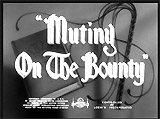



Mutiny on the Bounty (1935), 133 minutes, D: Frank Lloyd
A classic adventure, Best Picture-winning film based upon Nordhoff and Hall's account of the hardships aboard an 18th century British man-of-war, the H.M.S. Bounty, on a naval sea expedition in 1789 in the remote South Pacific in search of breadfruit. The first (and best) of the filmic versions of the familiar tale, that was two years in the making and over-budget. Heartless, ruthless, sneering, arrogant and sadistic Captain Bligh (Charles Laughton) subjected the crew to cruel suffering and degradation during his abuse of power (including a brutal flogging resulting in the death of the ship's sickly doctor), provoking heroic, fair-minded first officer Fletcher Christian (leading man Clark Gable) to lead them into a mutiny on its return voyage, and setting Bligh adrift on the high seas.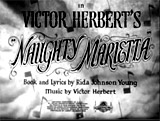

Naughty Marietta (1935), 106 minutes, D: W.S. Van Dyke II
The very first film teaming of the famous romantic and singing duo Nelson Eddy and Jeanette MacDonald - a major box-office hit at the time. Based upon Victor Herbert's 1910 operetta, set in 18th century France. An orphaned French Princess Marie de Namours de la Bonfain ("Marietta Franini") (Jeanette MacDonald), refusing an arranged marriage to Don Carlos, a Spanish man she didn't love, escaped to colonial America (New Orleans, Louisiana) by exchanging destinies with her maid. When pirates attacked the ship bound for America, she was rescued and fell in love with Indian scout Capt. Richard Warrington (Nelson Eddy). Although he left her when she played hard-to-get, he returned to locate his true love and took her with him into the frontier. With songs including "The Italian Street Song," "Tramp, Tramp, Tramp," "I'm Falling in Love," and "Ah, Sweet Mystery of Life."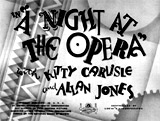

A Night at the Opera (1935), 92 minutes, D: Sam Wood
The first of five Marx Brothers films at MGM, a polished Marx Brothers comedy classic (their first film without Zeppo), one of their biggest hits, with famous routines and non-stop one-liners. Groucho played crafty promoter Otis B. Driftwood who wooed millionaire dowager Mrs. Claypool (perennial Margaret Dumont) and conned her into supporting an opera company with an investment of $200,000, so she could become a high-society member. With Fiorello (Chico) and Tomasso (Harpo), they all but destroyed and then eventually saved an operatic production. Memorable scenes included the crowded stateroom scene and the climax during the opening night performance of the grand opera.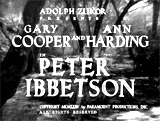


Peter Ibbetson (1935), 88 minutes, D: Henry Hathaway
Based on the 1891 published novel by George du Maurier. A story about a surreal, metaphysical, and transcendent romance between two who were separated as children and reunited by destiny years later - and also spiritually after death. The two were: Parisian architect Peter Ibbetson (Gary Cooper), commissioned to design stables on the property of British Duke of Towers (John Halliday), and the Duke's lovely wife Duchess Mary of Towers (Ann Harding). During his work, Ibbetson recognized Mary as his long-lost childhood friend named Mimsey that he had played with in the same garden, when his name was Gogo. The Duke's jealousy led to the accidental death of the Duke during a struggle with Ibbetson, and he was unjustly sentenced to life in prison (although it was self-defense). Incarcerated, he had many surreal visions and dreams of his lover Mary - and a promise of eternal happiness with her - fulfilled with her after they both died and had a final rendezvous together.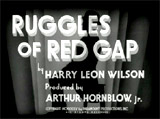


Ruggles of Red Gap (1935), 76 minutes, D: Leo McCarey
One of the best (and funniest) screen comedies ever made. Most noted for Laughton's reading of the Gettysburg Address - while drunk. The Earl of Burnstead (Roland Young), an English nobleman, lost his valet butler Marmaduke Ruggles (Charles Laughton) to a wealthy, visiting American ranching couple Effie (Mary Boland) and Egbert Floud (Charles Ruggles) during a poker game. Accompanying his rough-and-ready, uncouth new employer from Paris back to his new home in the Wild Western town of Red Gap, Washington in 1908, the stiff, upper-lipped Ruggles had trouble, at first, adjusting to this informal, rowdy frontier town. He was able to break his indentured bonds of servitude and free himself from class restructions. He romanced and married Mrs. Judson (ZaSu Pitts), and opened a restaurant with her.


The Scoundrel (1935), 76 minutes, D: Ben Hecht, Charles MacArthur
Won an Oscar for Best Writing, Original Story (by directors Hecht and MacArthur) for its witty script and great lines of dialogue, and its theme of redemption. Both Hecht and MacArthur had cameos as bums in the flophouse scene. Also included the film debut of Burgess Meredith as a minor uncredited character. The American League of Decency banned the film. A manipulative, unpleasant and ruthless New York publisher/writer Anthony Mallare (Noel Coward in his first starring film role) survived by using everyone he came into contact with. He destroyed the career and life of aspiring young author Paul Decker (Stanley Ridges) who soon lost his career and self-respect. As a cold-hearted, love 'em and leave 'em womanizer, he loved naive young poetess Cora Moore (Julie Haydon), Decker's fiancee and then abandoned her after 6 months for a new lover, a concert pianist. Cora cursed him - hoping his plane crashed and that he might die, and thinking that no tear would be shed for him. When he actually perished on a Bermuda-bound airplane flight, his ghostly spirit was allowed to return to the world for one month to wander the Earth to atone for his actions, if he could find anyone who mourned his passing.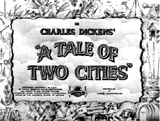

A Tale of Two Cities (1935), 120 minutes, D: Jack Conway (and Jacques Tourneur for second-unit sequences)
A lavish MGM film adaptation of Charles Dickens' monumental classic novel of the French Revolution, and a blockbuster film for David O Selznick. Filmed twice in the silent era, in 1911 and 1922, and also in the sound era in 1958 and 1980. Dissolute Sydney Carton (Ronald Colman), an aimless and carefree London lawyer, found his purpose in aiding beleaguered and downtrodden victims of the Reign of Terror after the French Revolution. He heroically sacrificed his own life to save another man Charles Darnay (Donald Woods) from the guillotine and for the love of the woman Lucie Manette/Darnay (Elizabeth Allan) that they both loved. With Carton's haunting and famous last words before his execution: "It's a far, far better thing I do than I have ever done. It's a far, far better rest I go to than I have ever known."



The 39 Steps (1935, UK), 87 minutes, D: Alfred Hitchcock
One of the all-time great thrillers, Hitchcock's first great masterpiece. In London, a visiting/vacationing Canadian rancher Richard Hannay (Robert Donat) attended a Palladium vaudeville act. When a shot rang out, he ended up in the company of a frightened woman, a female British agent Miss Annabella Smith (Lucie Mannheim). He was given a map of Scotland and told about an international spy ring (with vital national security secrets) run by a man missing part of one finger. Sheltering her for the night, she was murdered, and he found himself as an innocent man who must avoid police authorities (who suspected him of the murder) and pursuit by spies (who wanted to silence him). He took on her mission, and following the only clues he had, ended up in Scotland. On the way, he was handcuffed by the spies to a strange woman Pamela (Madeleine Carroll), who at first hated him believing he was a criminal, but ended up in love with him and helped him solve the case.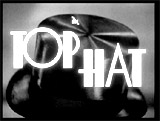




Top Hat (1935), 101 minutes, D: Mark Sandrich
From RKO Studios, the fourth film teaming the dancing pair Astaire/Rogers, possibly their best (and most successful) work, with choreography by Hermes Pan and Astaire, beautiful Art Deco sets, and integrated music from Irving Berlin. American dancer Jerry Travers (Fred Astaire) pursued the romantic love of his life Dale Tremont (Ginger Rogers) from London, England to Venice, Italy. In London, he first met her in the hotel when his loud tap-dancing awakened her in the room below. In a complicated and comical case of mistaken identity, she thought he was married to her best long-suffering friend Madge Hardwick (Helen Broderick). Despite Dale's marriage to a rival Italian fashion designer Alberto Beddini (Erik Rhodes), in anger, Astaire and Rogers were reconciled and reunited in a gondola by film's end. Memorable Irving Berlin songs/dances included: "Isn't This a Lovely Day (To Be Caught in the Rain)," "Top Hat, White Tie and Tails," "Piccolino," and "Cheek to Cheek."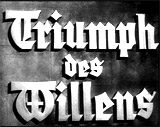

Triumph of the Will (1935, Germ.) (aka Triumph Des Willens), 114 minutes, D: Leni Riefenstahl
Nazi Fuhrer leader Adolf Hitler commissioned dancer/actress-turned filmmaker Leni Riefenstahl to make this notorious documentary to record and celebrate the sixth Nazi Reich Party Congress held in September 1934 in Nuremberg. This spectacular propagandistic film glorified and praised the might of the unjust and evil Nazi regime and state with masterful images, rapid cuts, a Wagnerian score, and ingenious camera angles and compositions. This infamous, extravagant two-hour film is still considered the most powerful propaganda film ever made, with grandiose opening shots of Messianic Hitler's arrival by plane, his heroic entrance and adulation by saluting ("Sieg Heil") multitudes and uniformed party members and soldiers (and Hitler Youth), and his charismatic exalted character during rousing speeches.